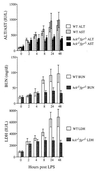Resistance to endotoxic shock and reduced neutrophil migration in mice deficient for the Src-family kinases Hck and Fgr
- PMID: 9636192
- PMCID: PMC22689
- DOI: 10.1073/pnas.95.13.7580
Resistance to endotoxic shock and reduced neutrophil migration in mice deficient for the Src-family kinases Hck and Fgr
Abstract
Signal transduction through the leukocyte integrins is required for the processes of firm adhesion, activation, and chemotaxis of neutrophils during inflammatory reactions. Neutrophils isolated from knockout mice that are deficient in the expression of p59/61(hck) (Hck) and p58(c-fgr) (Fgr), members of the Src-family of protein tyrosine kinases, have been shown to be defective in adhesion mediated activation. Cells from these animals have impaired induction of respiratory burst and granule secretion following plating on surfaces that crosslink beta2 and beta3 integrins. To determine if the defective function of hck-/-fgr-/- neutrophils observed in vitro also results in impaired inflammatory responses in vivo, we examined responses induced by lipopolysaccharide (LPS) injection in these animals. The hck-/-fgr-/- mice showed marked resistance to the lethal effects of high-dose LPS injection despite the fact that high levels of serum tumor necrosis factor alpha and interleukin 1alpha were detected. Serum chemistry analysis revealed a marked reduction in liver and renal damage in mutant mice treated with LPS, whereas blood counts showed a marked neutrophilia that was not seen in wild-type animals. Direct examination of liver sections from mutant mice revealed reduced neutrophil migration into the tissue. These data demonstrate that defective integrin signaling in neutrophils, caused by loss of Hck and Fgr tyrosine kinase activity, results in impaired inflammation-dependent tissue injury in vivo.
Figures





Similar articles
-
Deficiency of Src family kinases p59/61hck and p58c-fgr results in defective adhesion-dependent neutrophil functions.J Cell Biol. 1996 May;133(4):895-910. doi: 10.1083/jcb.133.4.895. J Cell Biol. 1996. PMID: 8666673 Free PMC article.
-
The Src family kinases Hck and Fgr are dispensable for inside-out, chemoattractant-induced signaling regulating beta 2 integrin affinity and valency in neutrophils, but are required for beta 2 integrin-mediated outside-in signaling involved in sustained adhesion.J Immunol. 2006 Jul 1;177(1):604-11. doi: 10.4049/jimmunol.177.1.604. J Immunol. 2006. PMID: 16785558
-
Adhesion-dependent degranulation of neutrophils requires the Src family kinases Fgr and Hck.J Immunol. 1999 Jan 15;162(2):1120-6. J Immunol. 1999. PMID: 9916742
-
Integrin signal transduction in myeloid leukocytes.J Leukoc Biol. 1999 Mar;65(3):313-20. doi: 10.1002/jlb.65.3.313. J Leukoc Biol. 1999. PMID: 10080533 Review.
-
The p60c-src family of protein-tyrosine kinases: structure, regulation, and function.Crit Rev Oncog. 1992;3(4):401-46. Crit Rev Oncog. 1992. PMID: 1384720 Review.
Cited by
-
The Src-Family Kinases Hck and Fgr Regulate Early Lipopolysaccharide-Induced Myeloid Cell Recruitment into the Lung and Their Ability To Secrete Chemokines.J Immunol. 2015 Sep 1;195(5):2383-95. doi: 10.4049/jimmunol.1402011. Epub 2015 Jul 31. J Immunol. 2015. PMID: 26232427 Free PMC article.
-
Weighted gene correlation network analysis identifies microenvironment-related genes signature as prognostic candidate for Grade II/III glioma.Aging (Albany NY). 2020 Nov 7;12(21):22122-22138. doi: 10.18632/aging.104075. Epub 2020 Nov 7. Aging (Albany NY). 2020. PMID: 33186124 Free PMC article.
-
The pathogenicity of human immunodeficiency virus (HIV) type 1 Nef in CD4C/HIV transgenic mice is abolished by mutation of its SH3-binding domain, and disease development is delayed in the absence of Hck.J Virol. 2001 Oct;75(19):9378-92. doi: 10.1128/JVI.75.19.9378-9392.2001. J Virol. 2001. PMID: 11533201 Free PMC article.
-
Identification of the Shared Gene Signatures of HCK, NOG, RNF125 and Biological Mechanism in Pediatric Acute Lymphoblastic Leukaemia and Pediatric Sepsis.Mol Biotechnol. 2025 Jan;67(1):80-90. doi: 10.1007/s12033-023-00979-6. Epub 2023 Dec 20. Mol Biotechnol. 2025. PMID: 38123749 Free PMC article.
-
Hematopoietic cell kinase (HCK) as a therapeutic target in immune and cancer cells.Oncotarget. 2015 Jun 30;6(18):15752-71. doi: 10.18632/oncotarget.4199. Oncotarget. 2015. PMID: 26087188 Free PMC article. Review.
References
Publication types
MeSH terms
Substances
Grants and funding
LinkOut - more resources
Full Text Sources
Other Literature Sources
Miscellaneous

